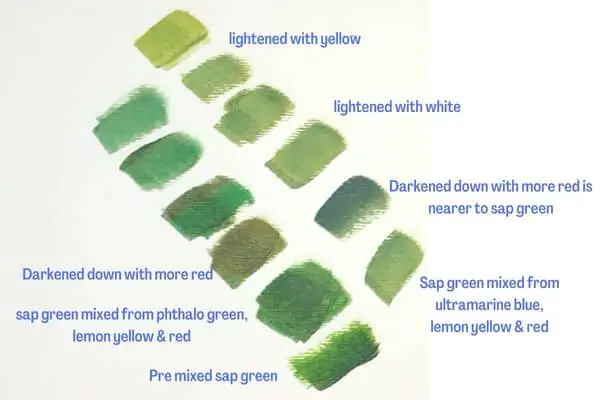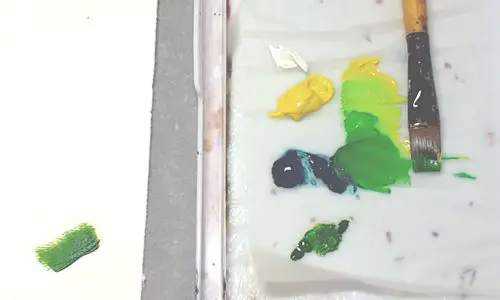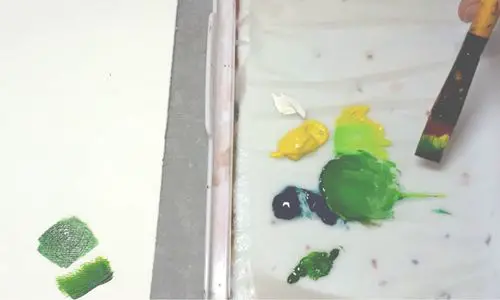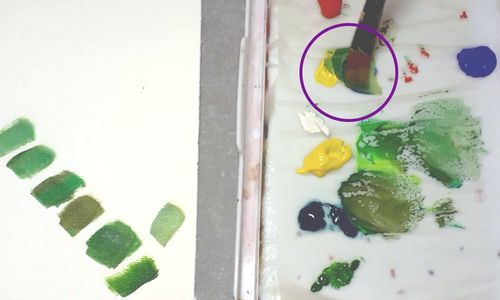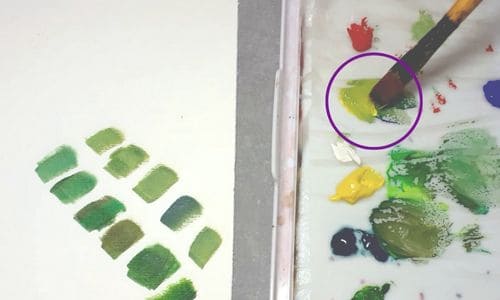Sap green is an easy color to make in acrylics and oils. Most people will have the colors they need or similar colors already in their palette.
To make sap green you mix ultramarine blue, lemon yellow, and cadmium red together. Alternatively, you can mix phthalo green, lemon yellow, and cadmium red together.
Below I cover these two methods of making sap greens of varying lightness and darkness using both the color mixes above step by step. I use a premixed color as a standard guide. I also have a video guide if you need it.
How to Make Sap Green paint with Acrylics or Oils – Method 1
You need to have these colors for method one:
- Cadmium red or another warm red without any blue in it.
- Lemon yellow a yellow leaning toward green
- Titanium white
- Phthalo Green/ A blue-green. Watch this one it’s a very powerful color. If you don’t have this green you could try phthalo blue or pop down to the 2nd way of mixing sap green with ultramarine blue.
Other materials
- Brush or pallet knife for mixing.
- Palette.
- Paper or board suitable for acrylic paint.
Mix together the phthalo green and lemon yellow (or your substituted colors). use a small amount of green as it is very powerful. You can see below the general color you are aiming for.
This is the first stage of green mixed. (Note the color on the left is what we are aiming for)
Add your red paint to the mix. Only add a tiny amount. It’s better to add a tiny amount and need to add more later than add too much. Don’t worry if you add too much simply add more of the green mix to it.
You can see that by adding the red it toned down the green and made it fairly close to the sap green we are aiming for. It looks slightly different here but on the dried finished sample it’s virtually identical.
Some people prefer to use black here to do the same thing. I’m not a big fan of using black where there’s an easy alternative but experiment to see which you prefer.
If you want a darker sap green you can add extra red color, or more phthalo green (careful with this color as it tips to its color quickly as you can see later in my top left mixes) or you can add black to the mix. You can see below that this changes the color slightly and darkens it. Here I only used more red.
2nd Way to Make Sap Green – Make Sap Green With The Primary Colors Of Ultramarine Blue and Lemon Yellow
I think I should have done this first as people are more likely to have ultramarine blue than phthalo green but never mind.
- Cadmium red or another warm red without any blue in it.
- Lemon yellow a yellow leaning toward green.
- Titanium white.
- Ultramarine Blue.
Other materials needed:
- Brush or pallet knife for mixing.
- Palette.
- Paper or board suitable for acrylic paint.
To mix sap green from ultramarine blue mix together the blue and the lemon yellow. Add the blue to the yellow until you get mid to darker green like below. I’ve left the first colors as a comparison.
Add a small amount of red to dull down the color.
To Lighten Your Sap Green Color
If you want to lighten your sap green color you can either add yellow or white. Both change the color slightly. White creates a slightly chalky look.
Use white to lighten your sap green color.
Use yellow to lighten your sap green color
Below you can see all the variations by changing your mixes slightly.
Interestingly the top right green lightened with yellow is nearest to Winsor and Newton premixed sap green. While my original sap green is from Daler Rowney’s System 3 range. You can see how much the green varies even among the brands.
How to Make A Deep Dark Sap Green
To make a deep dark sap green use the mixes above to mix a standard sap green and darken them down with red or black or start with a greater mix rather than a yellow.
What color can I substitute for SAP Green?
What Is SAP Green Made From?
According to Winsor and Newton sap green was “originally made from the juice of unripe berries from the buckthorn, (Rhamnus) plant.”
